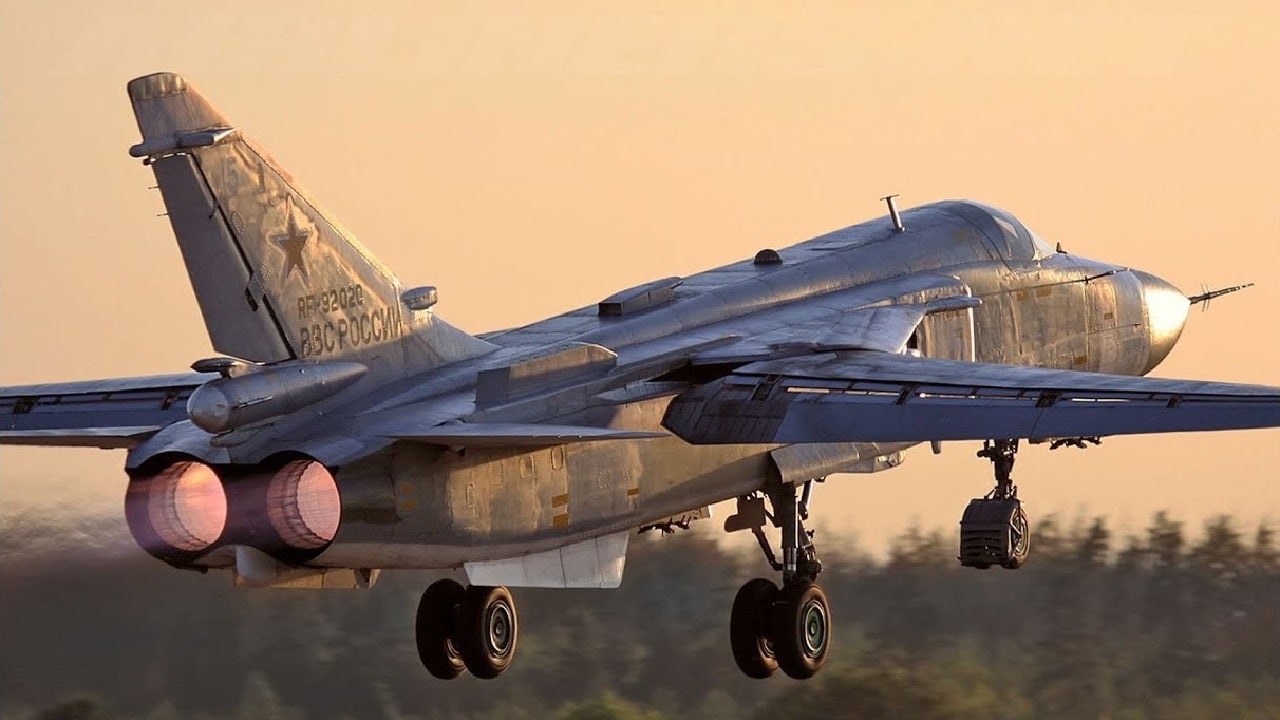While certainly a relic of the Soviet Air Force of the Cold War, Russia’s Su-24 remains in service today, even alongside newer attack aircraft designed to replace it. The Su-24’s life in Russian and other countries’ service around the former Soviet Union and the world has brought the Fencer (as it is referred to by its NATO designation) some infamy, including its service on both sides of Russia’s 2022 invasion of Ukraine.
Characteristics of the Su-24 Fencer
The Su-24’s configuration is clearly designed for its intended all-weather attack aircraft role. Its unique profile is shaped by its variable wings and side-by-side cockpit arrangement for its two crew members. Powered by two Salyut AL-21F-3 engines, the Fencer has a maximum speed at an altitude of 1,000 miles per hour and a range of roughly 370 miles, according to Russian state media. In addition to its 23mm GSh-6-23M cannon, the Su-24 has eight hardpoints that can carry a combination of guided air-to-air and air-to-surface missiles, unguided rockets, and freefall bombs. The Fencer is nuclear-capable.
Development of the Su-24 Fencer
According to Russian sources, the Sukhoi Design Bureau began the development of the Su-24 in the 1960s, which culminated in the aircraft’s first flight in 1970. While 1973 marked the first deliveries of the base version of the aircraft to the Soviet Air Force, the Su-24 did not officially enter service until 1975. Serial production of this version continued until 1983 when a modernized version of the Su-24M entered production instead. This modernized version of the Su-24 included upgrades to the Fencer’s sight and navigation systems and was serially produced alongside other variants designed specifically for export, jamming, or reconnaissance until 1993.
Service History of the Su-24
One of the most prominent deployments of the Su-24 in its history before Russia’s invasion of Ukraine was its use in Russia’s intervention in the Syrian civil war on behalf of the Syrian Assad regime, as well as by local pilots loyal to the Syrian dictator themselves. Su-24s were at the focal point of international crises multiple times, as Syrian- and Russian-piloted Fencers were shot down by Turkish forces at various points during the conflict. Russian Su-24s have primarily participated in bombing missions against Syrian opposition group during Russia’s mission.
Despite its continued service in the air forces of both Ukraine and Russia, most losses of the Fencer appear to be on the Ukrainian side. Both Ukraine and Russian sources have claimed to have shot down Su-24s of their opponent, although the noted open-source intelligence blog Oryx has only confirmed the loss of four Ukrainian Su-24s. Nonetheless, Russia is employing its Su-34s in greater numbers against Ukraine, which has taken non-negligible losses themselves despite being the more-advanced replacement to the Su-24.
Future of the Su-24
Despite plans to retire the Su-24 from the Russian Aerospace Forces by 2020 according to Russian state media, the planned replacement of the Fencer by the Su-34 attack bomber does not appear to be imminent, or even on the horizon in the near future. As recently as 2018, the Russian Ministry of Defense officially claimed that the battlefield service of the Su-24 in Syria had breathed new life into the aircraft’s service life, especially when equipped with avionics upgrades such as the SVP-24 “Gefest” computer system. At that point, the Russian Aerospace Forces declared their intention to agglomerate all remaining modernized Su-24s into two air regiments. Su-24s operated by other countries such as Iran, Algeria, Sudan, Syria, Libya, and Ukraine could remain in service for even longer for a variety of individual reasons, including a lack of interest or ability to get their hands on Russian produced Fencer replacements.
Based on Russia’s flip-flopping on the future of the Su-24 alongside more modern attack aircraft such as the Su-34, it is more likely than not that the Fencer will stick around for some time to come.
Wesley Culp is a Research Fellow at the Center for the Study of the Presidency and Congress. He regularly writes on Russian and Eurasian leadership and national security topics and has been published in The Hill as well as in the Diplomatic Courier. He can be found on Twitter @WesleyJCulp.

